With so many anglers, myself included spending more and more time targeting fish with lures these days, less and less people seem to enjoy the basic art of bait fishing.
Many of us cut our teeth bait fishing for bread and butter species such as redfin, trout and even dirty old carp. While I thoroughly enjoy the sport of lure casting myself, I also love to just take a few steps back to my roots as an angler, tie on a hook and sinker and do a bit of relaxing bait fishing.
The flyfishing community have a saying they use called ‘matching the hatch’. For them this means tying on a fly to match whatever insects are hatching, or what the trout may be feeding on. Bait anglers need to do the same thing.
Trout can be selective, and will usually only feed on whatever is in the system at any given time, so it is critically important to match the hatch by choosing a bait that may be entering the waterway somehow.
For example, in the middle of February, when the ground is as dry as a bone, the streams are barely trickling over the small rocks and the water is low in oxygen, you would not use worms. Why, because they are not there and trout aren’t looking for them.
In September, after the winter rains when the ground is saturated, the little feeder gullies are all running, with water flowing off the farmers paddocks, there will be worms everywhere in the streams, so then you would use worms. At that same cold damp time of year, when there are no grasshoppers or crickets around, you would not use crickets of grasshoppers. I have heard of people freezing crickets and using them at a later date. While this may work, it will only work properly when the crickets are available naturally to the trout, in March and April, not cold damp September.
Back to our low flowing February stream. We have ruled out worms, so what would we use for bait? Grasshoppers are the gun bait because there are usually a more than a few around at that time of year.
The best advice I can give is to go for a walk along the riverbank, kick some grass around and see whether there are any grasshoppers around. If there are a few, then catch some and put them on the hook. If there aren’t any grasshoppers, then turn some rocks over and see if there are any crickets around.
At that hot time of year, even if there are no grasshoppers or crickets, there are almost always flies, and if you're lucky those annoying march flies that like to sting us will most likely be not too far away. You really need to use some initiative, and find something that you think the trout might like to eat that is active in the environment. Big cockroaches are an excellent alternative.
Trout are not terribly fussy feeders, just cunning. I remember when my grandfather was still alive, he told me a story about the day he was fishing in December in the Buffalo River, back in the 1970s. He was drifting worms and could not get a bite all day. Later in the afternoon he got bitten by a march fly. So he swatted the march fly, only wounding it. He put that march fly onto a tiny hook and drifted it into a deep backwater and caught a 2lb brown trout on it. My grandfather said he caught quite a few trout on march flies that afternoon!
Mudeyes are the larvae stage of dragonflies. Although dragonflies are usually only found in the warmer months, this does not mean there are no mudeyes. Mudeyes will live underwater clinging to underwater foliage such as submerged bushes or aquatic weed. They will cling on for as long as it takes for the weather conditions to be suitable for them to climb out and hatch. When the weather is warm enough they will climb out of the water and hatch their wings and fly away. At this stage they usually have a sense of pride after surviving the underwater world of the hungry trout, and while feeling happy, safe and proud only to get eaten by a hungry bird instead!
Mudeyes are a suitable year round bait even though there are no dragonflies buzzing around. The best places to bait fish with mudeyes are areas with plenty of aquatic vegetation, particularly lakes. They do make a very good bait in streams as well though, particularly bigger rivers where you can fish them with a float. Fishing a live mudeye under a float in a lake is one of my favourite forms of fishing!
Bait fishing does not require you to take out a bank loan to purchase an expensive ultra light graphite rod with an expensive reel on it. As you are not making cast after cast for hours on end, you really just need something that can cast the bait out a reasonable distance. When buying a new rod, rather than choosing your purchase by rod construction, or by price tag, you are far better off choosing your purchase by rod length. Here are a few examples.
Drifting bait in small mountain streams, a rod of around 6ft will be adequate. In larger rivers, a longer rod of close to 7ft might be desirable to help achieve better casting distance with a light weight. If fishing in a lake from the bank, maybe a really long rod of between 7-8ft would be your best bet for the same reason, to achieve greater casting distance.
When fishing with a float, a long rod comes in very handy as the main casting weight, (the float) is usually some distance up from the hook. For example, if your hook is 1.8m underneath your float, then you will need a long rod to hold up high when you cast to prevent the hook getting fouled up on anything.
There are plenty of great value reels for around $50-$100 that will suit basic bait fishing. Of course if you already have quality gear then so much the better.
When drifting bait in streams there are two main techniques to use. One is the traditional trout fishing way, to walk upstream casting upstream and drifting the bait back towards you, and the other is to flick the bait out and let the current wash your bait into a hole, or backwater from upstream. The second option is preferable in dirty water, as the trout will most likely see you standing there if the water is too clear. When flicking the bait upstream, I like to reel the slack line in slightly faster than the current is washing my bait downstream towards me. This allows me to keep a reasonably tight line so that I can feel any fish nibbling at my bait.
When allowing my bait to drift downstream, it is much more about guesswork. I usually open the bail, let the current take my bait, give it a few seconds and then close my bail and feel for weight.
As a rule of thumb, I like to use the lightest possible split shot sinker that I can get away with. The deeper the water and faster the current, the heavier sinker I will need. In most streams when fishing with worms I will use one tiny split shot sinker just to aid casting and to help my bait sink. When fishing with crickets or grasshoppers I will cast them totally unweighted, just using the weight of the bait and the hook to cast. When using mudeyes I prefer to either fish them totally unweighted, or fish them underneath some kind of float.
Hook sizes for trout need to be very small to match the size of the bait. As a rule of thumb with any type of bait fishing, the smaller the hook the easier it is to hook the fish, but the easier the fish can get off. Quite often a bigger hook will be harder to set in the fishes mouth, but once the fish is hooked it stays on. When bait fishing for trout I like to use a hook of around # 8 or 10. It depends a lot on the bait to. One large fat scrub worm may need a bigger size 6 or even size 4 hook, whereas a small skinny tiger worm might be well suited to a size 10 hook.
Rigs are not complicated for trout fishing. As with most of my fishing I like to keep things simple. When fishing with worms in a stream I like to just tie the line to the hook, and crimp a small split shot or two about 30cm up the line: as simple as that. When drifting crickets or grasshoppers I just tie the hook to the end of the line. You could barely call that a rig! When float fishing, it is much the same however instead of crimping on a split shot, I am attaching a bubble float to the line. The distance I attach the float up from the hook depends on how deep the water is and how much weed is in the water.
Ideally I like my bait to be suspended just above the aquatic weed, or the bottom.
Bait fishing is a terrifically relaxing branch of our sport that shouldn’t be ignored. It can be challenging and very rewarding indeed.
Facts
Common Baits
January: grasshoppers, flies, mudeyes.
February: grasshoppers, flies, crickets, mudeyes.
March: crickets, grasshoppers, flies, mudeyes.
April: crickets, grasshoppers, flies, mudeyes.
May: worms (subject to rain) mudeyes, crickets.
June: worms, mudeyes, crickets.
July: worms, mudeyes. (Lakes only in victoria)
August: worms, mudeyes. (Lakes only in victoria)
September: worms, mudeyes.
October: worms, mudeyes, grasshoppers. (subject to weather conditions towards the end of the month)
November: worms (subject to October rainfall and river heights) mudeyes, grasshoppers, flies.
December: grasshoppers, flies, mudeyes.
Other baits such as wood grubs and cockroaches can be found year round, depending upon the area.
troutbait12)
Brenton Richardson fishing a nice deep pool in a small stream. A nice hole like this would be ideal for drifting a cricket, or a mudeye into as the trout will be sitting under that undercut bank waiting for food to wash in.
troutbait13)
This photo of Khancoban Pondage looks almost black and white. If you look really closely, you can see my fluorescent orange bubble float sitting on the water's surface in the bottom right hand corner. Suspended under the float was a live mudeye. This was taken in the depths of winter where we managed to catch 4-5 nice trout, all on live mudeyes. The icy cold water pretty much put the mudeyes to sleep, but the trout still took them.

Mic Rybka with a magnificent rainbow trout caught off the bank at Brushy Lagoon in Tasmania using Powerbait for bait. Powerbait is readily available at most tackle stores and works exceptionally well in waterways stocked with advanced trout such as family
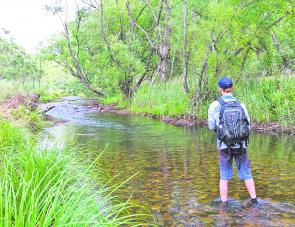
Look at this magnificent stretch of water. Streams with plenty of tussocks and grass along the banks are ideal places to drift grasshoppers in summer when the water is low and clear.
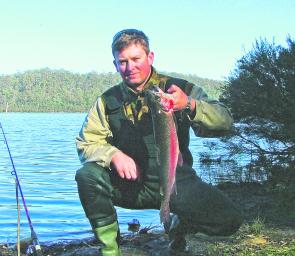
Mic Rybka with cracking Brushy Lagoon rainbow trout, caught on Powerbait while fishing from the bank.


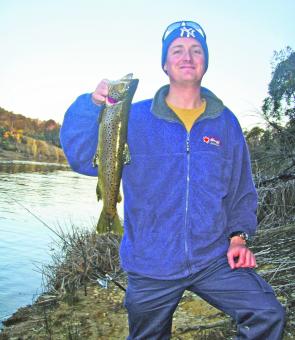
Craig Harvey with a decent brown trout caught at Curries River dam in Tasmania using Powerbait.

A small rainbow trout caught drifting a lightly weighted bunch of garden worms into a swollen stream. Note that the hook is a knotless hook. These are particularly handy when you are likely to be changing hooks. You can unwind the line, and change to anot

A great punnet of garden worms fit for a king trout. Scrub worms are excellent bait, but in my personal opinion garden worms work just as well when the trout are feeding on worms.

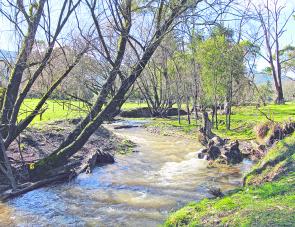
This tiny stream is quite high and off colour and ideal for drifting worms. Look for a calmer backwater or somewhere with a bit less current.
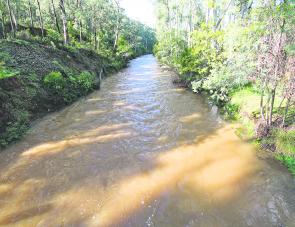
The Buckland River in North East Victoria looking very angry. High dirty water like this is ideal for drifting worms. Fish your worms as close to the bank as possible where the trout often sit out of the current and wait for worms to wash in.

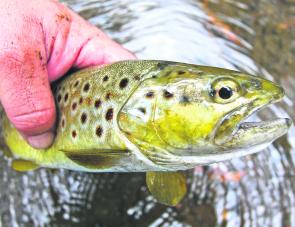
This brown trout took a liking to a bunch of worms in a small stream before the end of last season after some late May rainfall.




